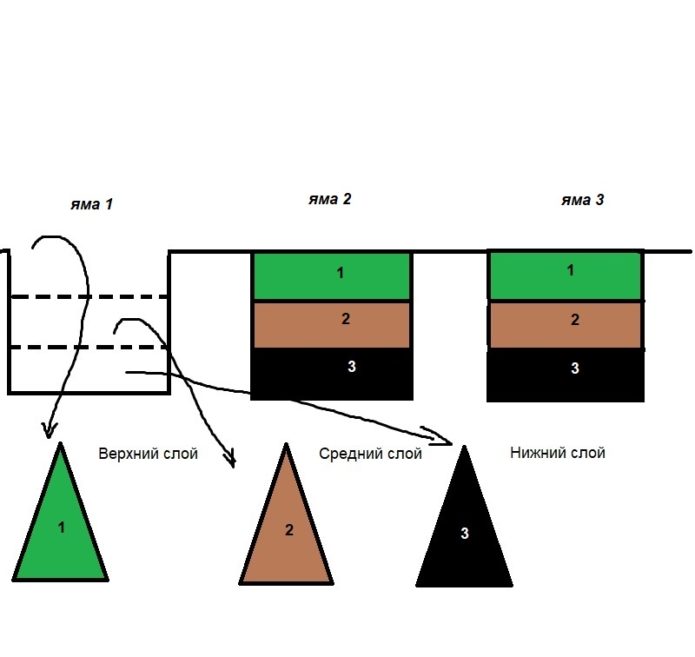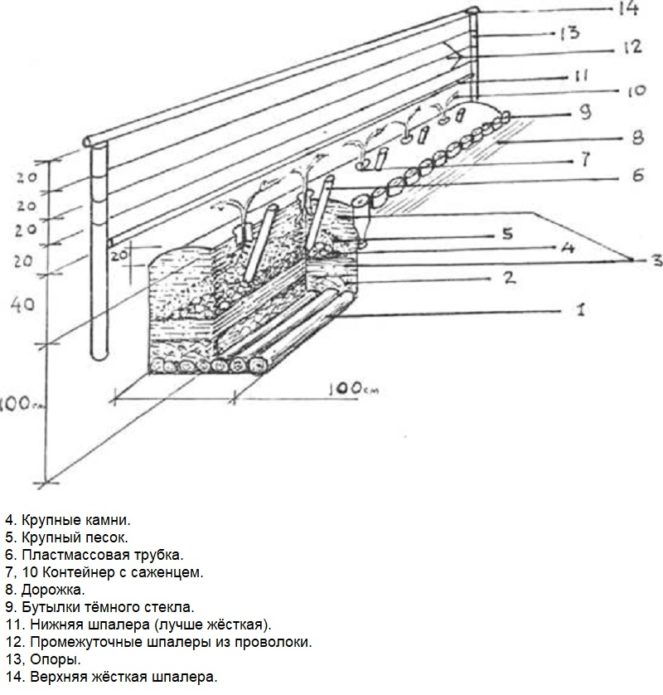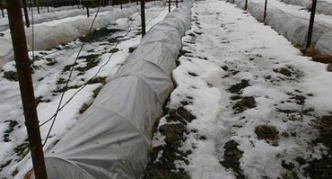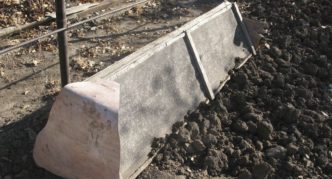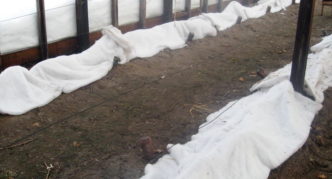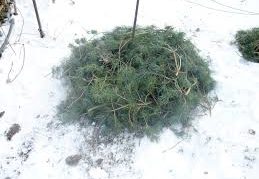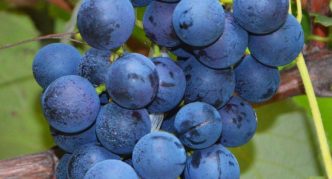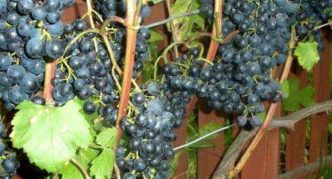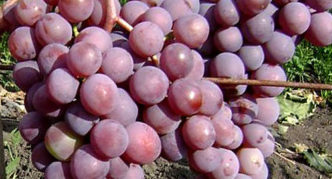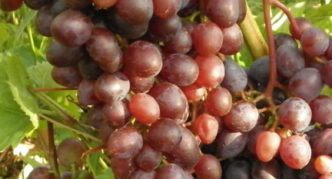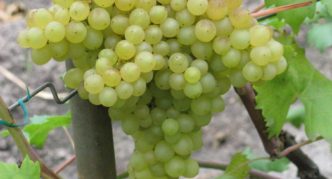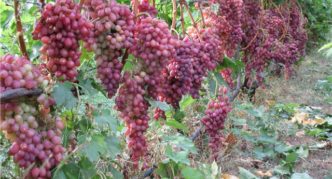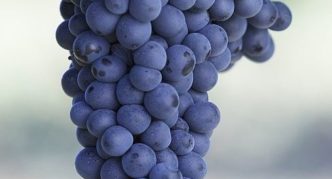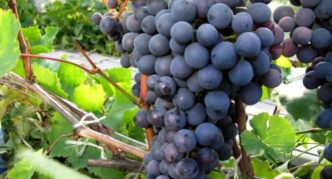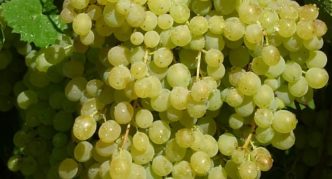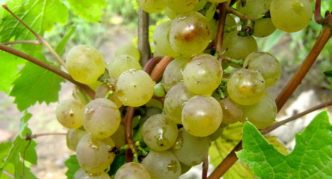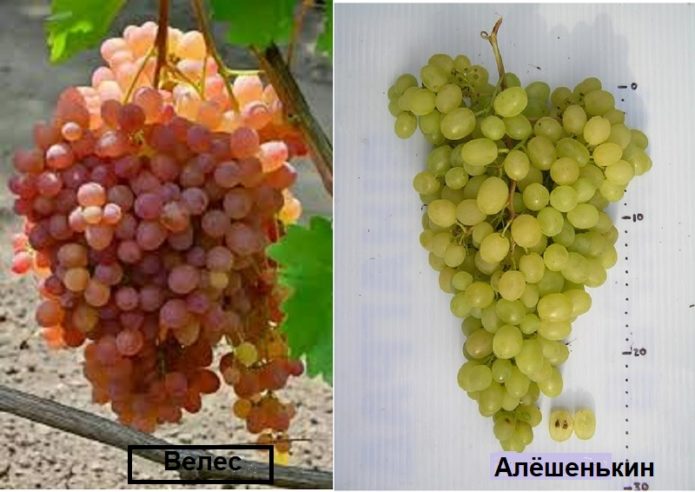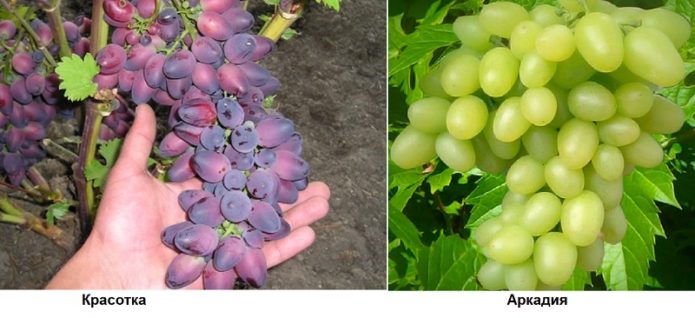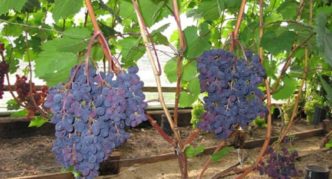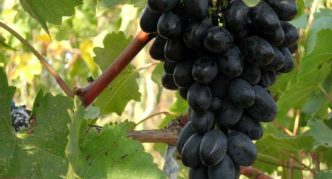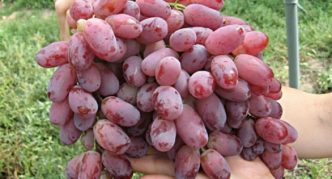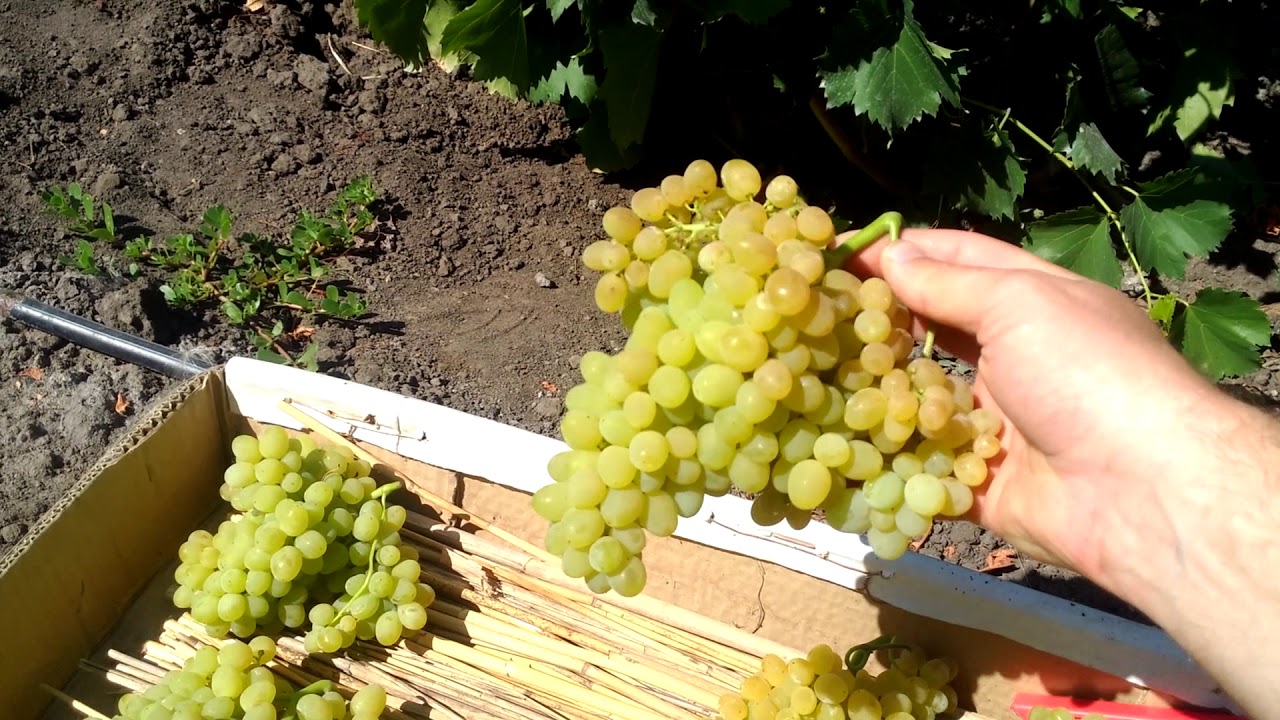For a long time Belarus was identified with bulba (potato) - the dominant agricultural crop. And the inhabitants of the republic were affectionately nicknamed "Bulbash". Now, in many Belarusian courtyards, grapes flaunt in a place of honor, organically blending into the local flavor. And now the word "winegrower" is added with good reason to the nickname of local residents.
Content
What influences the choice of grape variety in Belarus
But in fact, grapes in the land of partisan glory look strange - the weather seems to be unsuitable, and the bunches are so luxurious! Let's look at the natural and climatic potential of Belarus and find out which grape variety is capable of bearing fruit here.
Warmly
Grapes are a priori heat-loving plant. For normal vegetation, the formation of ovaries and the accumulation of sugar in the berry, you need warmth. Each region has certain thermal resources that determine the choice of the variety. The average monthly temperature should be +16 ° C. In the north of Belarus, in mid-June and in July, + 26 ... +28 ° C does not happen, so varieties with a high heat demand will not survive. For this reason, the varieties Karaburnu, Original and Original white, Tatiana, Krasa Dona after varietal tests have lost their prospects for Belarus. Varieties with a growing season of 140 days are not suitable even for greenhouses, and for open ground they are not suitable with a period of more than 125 days. In the conditions of the north, the possibilities of the variety appear only in the seventh year in the open field, and in the fifth in the greenhouse, so there is no need to waste time on dubious experiments.
The southern part of Belarus is best suited for growing grapes. As a result of warming over the past quarter century, the temperature in the country has increased by 1.1 ° C. Because of this, the borders of agro-climatic zones "crawled" from north to south. So a new agro-climatic zone appeared within the Brest and Gomel regions, with the warmest weather - the sum of active air temperatures here is more than 2600 ° C (!) - a paradise for mid-season varieties.
The average annual temperature minimum determines the method of growing grapes - covering or non-covering. The required sum of active temperatures for very early grape varieties is 1900–2200 ° C; early - 2200-2400 ° C and mid-early - 2400-2600 ° C.
In order to accumulate and retain precious heat, grapes are planted under the cover of the walls of houses or outbuildings, continuous fences from the south and south-west sides... The peculiar screens also protect the plants from the wind, which dissipates precious heat. As a result, it is 1–1.5 ° C warmer under the wall of the house at any time of the day, and the sum of active temperatures increases by 200–300 ° C.
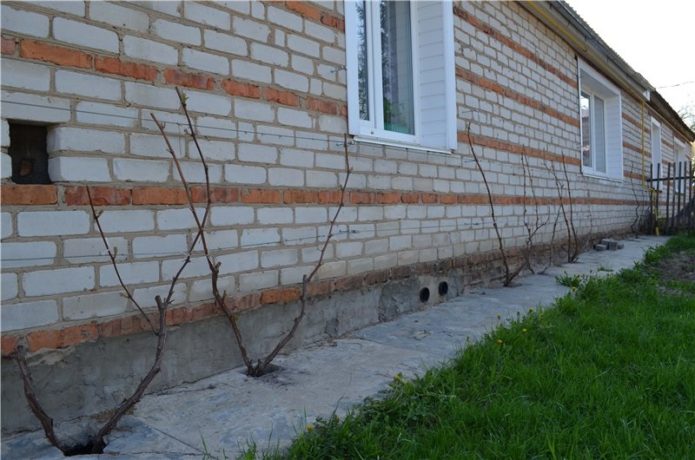
Under the wall of the house and on the south side, the grapes receive a generous portion of sunlight and warmth
Determining the duration of the frost-free period, both spring return frosts and autumn cold snaps are taken into account. For reference, a dormant vine can withstand temperatures as low as -1 ° C, but buds and green shoots are killed at this temperature. Dormant fruit buds freeze at -5 ... -6 ° C, and swollen buds are contraindicated at temperatures below -2 ... -3 ° C. But in the fall, a drop in temperature to -1 ... -4 ° C does not affect the leaves and ripened shoots of grapes. In the south of Belarus, the frost-free period lasts 150-180 days, in the north - 140-150. Measures to improve the thermal regime are envisaged already at the stage of planting grapes, and attention is paid to each bush.
For our regions, it is not important how many degrees the varieties tolerate, but that they withstand our winters with a constant "bumpy" temperature from minus to plus (sometimes significant). Low temperatures for -28-30 in winter are not so common here, but they must be taken into account, of course. But the drops from -10 ... -20 to +5 and even +10 are not uncommon, but almost commonplace in recent winters. How these changes affect the vine and buds, especially in January - February (when the organic dormancy of the grapes has already ended), I think, there is no need to say much.
Moisture
Grapes are naturally drought tolerant, the roots of an adult plant penetrate deep into the ground and provide it with the necessary amount of moisture. The optimum soil moisture level for grapes should be between 70-80%. But Belarus is located in a zone of sufficient moisture, which exceeds the “grape” norm during the period of prolonged rains. If we add moisture-absorbing soils to this, then the picture emerges is completely disappointing. Excess moisture, undesirable at any time of the growing season, leads to decay of the roots and a delay in the dynamics of plant development.
Rains in the northern viticulture zone significantly reduce the air temperature and increase its humidity up to 100% (the norm for a culture is 60–80%) and is felt physically. The rains during the growing season lead to shedding of flowers and ovaries, and at the end of August they interfere with the process of sugar accumulation, decay of berries, and provoke fungal diseases.
The soil
The main part of the viticulture zone in Belarus is located on sod-podzolic soils, which occupy almost half of the country's territory. They are characterized by increased acidity - pH 3.3–5.5, a thin humus layer and a lack of nitrogen, phosphorus and potassium. Grapes are planted on acidic soils after a number of agrotechnical measures:
- liming - the acidity level is brought to neutral (pH 6.0-6.7);
- application of mineral and organic fertilizers to increase the thickness of the humus layer;
- drainage of the soil (if necessary).
Best of all in Belarus, grapes grow on cultivated loams. Since loams are characterized by light colors, they are "diluted" with peat crumb in large quantities, because dark soil warms up faster than light soil. Such an original method of increasing the thermal regime in the Belarusian style.
Plantage
The quality of soddy-podzolic soils is also improved with the help of a plantation, the essence of which is to move soil layers - the upper fertile down, and the lower infertile up. In Belarus, the average plantation depth is 60–70 cm, so that the roots of the grapes are in a well-heated and fertile soil layer. Plantage in the fall, and in the spring the beds or pits are filled up with fertile soil.
Before the plantation, a strip is marked on the site for the future grape garden, marking the planting sites of the bushes with stakes and ropes. The depth of the future pit will be 70 cm with an area of 100 x 100 m.
At the first pit, the top layer of soil is removed, setting it aside. The middle and bottom layers are also folded separately.
Remove the fertile layer from the second pit and immediately drop it to the bottom of the first pit. Then the middle layer returns there, and then the lower layer of earth from the first pit, which were laid in different directions. The first pit is full.

The top layer of soil from the second pit is thrown off to the bottom of the first and the middle and bottom layers are returned to their place
The middle and bottom layers are removed from the second pit, laying them in different directions.
They begin to dig the third hole, dropping the upper horizon of fertile soil into the second hole and filling it with the middle and then the lower layer removed earlier.
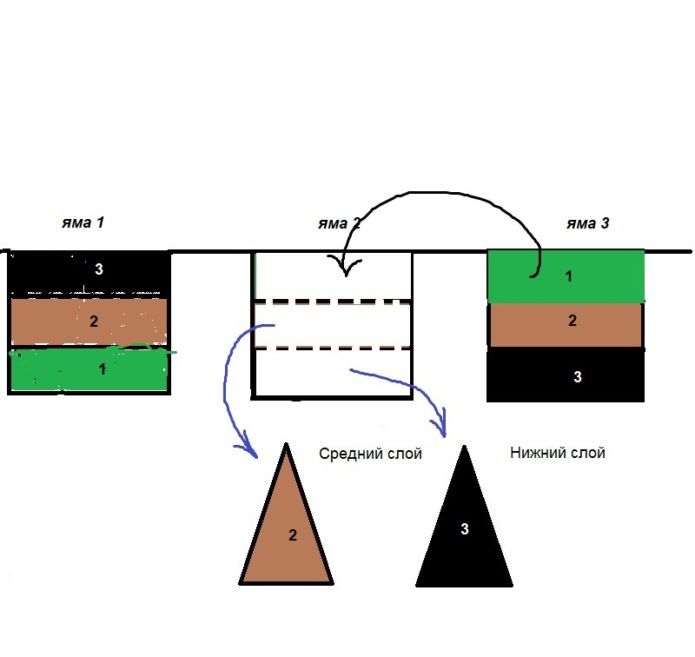
The first pit is ready, the middle and bottom portions of the soil from the second pit have been set aside. The upper horizon from the third pit is dropped to the bottom of the second, etc. according to the previous scenario
At first glance, you can get confused, but in practice everything is very clear. Each time the fertile horizon from the next pit is dropped to the bottom of the previous one and it is filled with “native” soil - first with the lower, and then with the middle layer. In fact, the middle layer of the earth remains in place, only the upper and lower horizons change in places. When plantation is carried out in strips, trenches are dug along the width of the strip, the "cycle" of the earth remains the same.
Planting northern grapes
When planting grapes, there are two purposes - to accumulate heat and prevent root rot.
Autumn arrangement of the landing pit:
- They dig a trench 0.8-1.0 m deep and 1 m wide. If a row of vines is planted, the length of the ditch is calculated based on the distance between the bushes - 0.75-1.1 m. The fertile soil is folded separately.
- On sandy soil with a groundwater height of more than 2.5 m, the bottom is compacted with soft clay.
- A layer of construction waste, plant residues, semi-rotted manure is poured.
- The previously deposited soil is mixed with clay, drainage (pebbles, broken brick) and humus, taken in equal parts. For each running meter of the trench, double superphosphate - 200 g, meat and bone meal - 1 liter, wood ash - 2 liters are added to the resulting substrate. Spread the prepared soil over the plant residues so that about 0.5-0.6 m remains to the edge of the trench.
- Large stones are laid mixed with rubble in a layer 15–20 cm thick.
- A plastic tube 3–5 cm in diameter is inserted into the stones at an angle; this is a probe through which the grapes will be fed and watered. The end of the tube is placed under the roots.
- Coarse sand is poured with a layer of 15–20 cm.
- The rest of the soil with fertilizers is poured on top. You should get a ridge with a height of about 20-30 cm.
- The prepared trench is left until spring to settle.
- In the spring, they add soil to make a ridge 20 cm high.
Plants are planted to a depth of 25-30 cm, this is how the soil warms up in the northern regions of Belarus. The upper trellis is made rigid, it will serve as the basis for a temporary greenhouse during recurrent frosts.
If the garden for grapes is not prepared, and the seedling is purchased, it is left to grow in a plastic bag with a volume of 10 liters. Why not in a bucket? It is easier to transplant from the package to a permanent place, it is enough to cut it from the bottom and lower it into the pit. The package is removed through the "head". So the earthy ball does not collapse, the roots are preserved intact and the seedling does not experience stress.
Top dressing
Nitrogen, phosphorus and potassium are the three fundamental ones, without which the normal development of the grape bush and the formation of a full-bodied bunch are impossible. Nitrogen requires special care in its use.It is irreplaceable during the active growth of shoots, leaves, antennae and bud formation.
An excess of phosphorus in the soil leads to fattening of the bush: until autumn, juicy green leaves flaunt on the grapes, the shoots do not ripen (they remain green, although they should turn brown). The berries of the fat bush are tasteless, watery and prone to decay.
Phosphorus is responsible for the development of the formation of the ovary, ripening of bunches and ripening of shoots. Potassium also contributes to the ripening of shoots and, most importantly, the accumulation of sugar in the berries.
Grapes under the age of three years inclusive are fed three times a year:
- When shoots begin to develop. Use nitrogen-phosphorus-potassium fertilizers or liquid organic matter.
- After 20-30 days, using a similar composition.
- When the shoots begin to ripen - this is about the end of July, nitrogen is excluded from the feeding.
For foliar spraying, it is convenient to use complex micronutrient fertilizers (Mik, Nutrivant Plus, Green Guy). Fertilizers of a new generation - Master (Italy) and Kristalon (Holland) - have become popular for root dressing in Belarus. Not for advertising - Crystalon is very convenient to use for both a specialist and a novice winegrower. Depending on the lack of nutrients or the stage of development of the grapes, a package with a pattern of a certain color is chosen. For example, blue denotes increased nitrogen + potassium and is used early and before flowering, while red packaging denotes increased potassium and is used during flowering and fruiting.
Fight against fungal diseases
The cool climate of Belarus becomes a real paradise for mildew or downy mildew - a fungal disease of grapes. The spores of the fungus are activated before or during flowering, covering the underside of the leaf with a white coating and showing up with pale yellow spots from the front.
Another enemy of grapes is oidium or powdery mildew, which appears at + 20 ... + 25 ° C. Such temperatures are not typical for southern regions, which cannot be said about Belarus. Oidium appears as a gray coating on the upper side of the leaves, gradually covering the entire plant.
Gray and black rot are faithful "friends" of prolonged wet weather. When infected, berries mostly suffer, and gray rot affects ripening ones, and black rot affects green grapes.
Prevention of fungal diseases includes:
- cultivation of zoned varieties;
- spraying, feeding is carried out in the morning or evening hours;
- unseen plantings;
- jet watering, without spraying the leaves;
- green operations - pinching, pinching the tops of shoots, breaking out;
- use of balanced fertilizers so as not to overfeed the bushes.
Biological means of prevention and protection against fungal diseases will be biological products Baikal M-1, Valagro, Albit, Novosil. Good results are obtained by prophylactic spraying of bushes with 10% milk whey. Processing is carried out in the period from the end of peeling to the beginning of ripening twice or three times with a week break.
The use of chemicals begins when the temperature rises to + 10 ... + 13 ° C and ends a month or a month and a half before harvesting (depending on the waiting period for a particular drug).
- Copper or iron vitriol in a concentration of 3-5% (depending on the age of the bush) - carry out spring spraying before bud break or autumn after harvesting.
- Bordeaux liquid - spraying before and after flowering, as well as before the berries ripen. After rain, the treatment is repeated.
- Shavit, Ridomil Gold - complex preparations for several rot. Processing is carried out before flowering.
Agrotechnical techniques
Of the many types of forming grape bushes in the northern part of Belarus, it is worth highlighting the capitate forming. Its essence lies in the fact that the fruit shoot is laid in an arc on the upper trellis, and the green shoots with bunches are not tied up, but hang freely.Due to the fact that they are directed not up, but down, their growth is naturally limited, and this minimizes the number of green transactions.

The capitate shape of the bush allows the green shoots to hang down, which is why the bush does not grow much
The vine is pruned in late October - early November. The grapes are propagated by rooting lignified cuttings with growing in plastic sleeves.
How to send grapes to winter
For the winter, grapes are sheltered when the cold snap becomes stable. The vines are bent to the ground, tied up and covered with heat-insulating material (spruce branches, dry non-caking grass). Rye straw is a good covering material; mice do not favor it. Under any shelter, you can spread the poison for rodents, and remove its remnants in the spring.
If we are talking about winter shelter with straw, then the danger, apparently, exists. True, the mice under the straw damaged my eyes only once, when I brought the straw straight from the farmyard and immediately spread it out. Apparently "scattered" the mouse's nest on the site. Usually, by the time the grapes are hiding, the mice have already found their winter shelter.
Above, they arrange an impromptu hut made of the same spruce branches, wooden shields over the entire width of the garden, cover them with polyethylene and fix them with something heavy. The ends of the "tunnel" are left open until severe frosts - freely circulating air will not allow condensate to accumulate... If there is no dampness in the shelter, and if it is covered with snow from above, the grapes will survive any frost.
Photo gallery: types of winter shelters of grapes for the winter
- Light cellophane shelters are used for relatively resistant grape varieties
- Straw - keeps heat well, and mice won't start under the rye straw
- Grapes winters well in huts made of boards covered with roofing material from precipitation
- In an unheated greenhouse, the synthetic winterizer shelter does not get wet and perfectly conserves heat
- Lapnik is a good insulating plant material, the vine under it remains dry
How to open grapes in spring
In the spring, the insulation is checked for dampness and is not removed until the return frosts have passed. At the same time, the ends are left open, in such conditions on the grapes buds may even wake up and shoots appear. In this case, the insulation is removed gradually, because the grape shoots are extremely fragile, and the broken shoot will expire with juice.
When it gets warmer up to + 15 ... + 20 ° C during the day, and at night + 3 ... + 5 ° C, the upper shelter is turned to one side to exclude the appearance of the greenhouse effect. For two days the vine “breathes” fresh air and dries up, after which prophylactic spraying with 3% Azophos is carried out to disinfect its surface. Then, water-charging irrigation is carried out, spending 20-30 liters of water under one bush.
It is not yet possible to fully open the grapes, because recurrent frosts are not excluded. For example, in 2017 there was a sharp drop in temperature to -7 ° C. It is terrible to imagine how many bushes opened before the deadline froze! But it is also impossible not to open the shelter, because the temperature under it rises and grape tops - the buds can start to grow. Since the earth has not yet warmed up, the roots of the grapes are still asleep, and the buds will live on the internal reserves of the cuttings. When nutrients are depleted, the kidneys tend to dry out.
Which variety to choose
Each person approaches the choice of a variety for different reasons. Any attempt at classification will result in the same varieties being repeated in one category or another. And for the inexperienced wine grower, we will only hint what you should pay attention to when choosing a variety.
Frost-resistant grape varieties
If you choose a super-frost-resistant variety, you should pay attention to the following:
- Juodupe has a vegetative period of 100–110 days, it can withstand temperatures as low as -30 ° C and if in the north of Belarus it is only bent down or a light shelter is made, in the southern regions of the country it hibernates on a trellis.Juodupe berries are blue, the skin is almost invisible when eaten, they have a barely noticeable strawberry aroma;
- Sharov's Riddle is an early variety that ripens regardless of weather conditions. The berries seem gray from a thick bloom of prune (wax bloom), they have a fickle flavor in a good way - either strawberry or some other. The mass of the bunch reaches up to half a kilogram. Frost resistance down to -32 ° C allows the bush to winter under the snow;
- New Russian - the variety can withstand temperature drops to -28 ... -30 ° C, berries are dark pink, weighing an average of 5 g, prone to cracking;
- Swenson Red is the record holder for frost resistance - up to -34 ° C. The bunch weighs from 300 to 500 g, in the north it ripens in the second decade of September. Berries to taste belong to the same "strawberry series", the wine from Svenson Red has an amazing aroma. The variety is resistant to fungal diseases. The female type of flower requires a pollinator. In some years, it is prone to peas.
I have a Juodupe bush. Pros: very early ripening (probably late July - early August). The vine ripens completely, according to this parameter it is the very first. And the taste is unusual - caramel-prune.
Photo gallery: super-frost-resistant varieties
- The variety is difficult to pronounce, the strawberry aroma of the berry is remembered faster
- The taste of this variety is difficult to define, but every time is wonderful.
- "New Russian" - the name, one might say, with meaning
- Swenson Red is one of the most frost-resistant varieties
Very early grapes
- Liepajas Dzintars - the vegetative period lasts only 90-100 days, therefore it belongs to the very early varieties. Ripens in mid-August. Amber clusters are small - up to 300 g, but very sweet, smell like nutmeg. The variety is frost and disease resistant;
- Makdalsky - ripens 15 days later, but also larger clusters - up to half a kilogram. The berries also smell like nutmeg, very sweet, resistant to cracking. The variety is distinguished by the full maturation of the vine. They cover for the winter.
Seedless varieties
- Radiant kishmish - has clusters weighing up to 1 kg, in the northern regions it begins to ripen from early to mid-September. The berries are pink-red in color with dense pulp and nutmeg aroma. Susceptible to fungal diseases;
- Kishmish 342 (Hungarian selection) is a vigorous variety, vegetation period 110-115 days. The berries are white, fleshy and sweet;
- In memory of Dombkovskaya - a variety with medium-sized bunches weighing an average of 370 g. It has remarkable properties: it is maximally resistant to diseases and pests, one-year growth always ripens, therefore, it tolerates wintering well. The berries are black, and the juice is deep pink. The recommended load on the bush is 40-50 eyes.
Photo gallery: raisins for Belarus
- Fleshy berries of Kishmish 342 in fresh form replace marmalade, and in dried form - raisins
- Luxurious pink bunches - the visiting card of the Kishmish Radiant variety
- The grape variety Memory Dombkovskaya is invariably stable and very tasty
Open field grapes
- Early northern - recognizable by white berries with a brownish barrel. Fungus resistance is average, requires 3-4 preventive treatments; hibernates under light cover;
- Agate Donskoy - uncovered at -26 ° C, the risk of damage is 10–20%. The average weight of the berry is 5 g, each with 2 seeds;
- Adel - the variety can withstand frosts down to -30 ° C, winters under spruce branches; in case of freezing it is well restored. Medium resistant to fungus; berries do not fall off. Aging does not depend on weather conditions;
- Rusbol is resistant to powdery mildew and mildew, therefore the treatments are preventive. The average weight of a bunch is 500 g, the maximum is 1 kg. The berries are white with a brownish barrel, without seeds. The variety is used as a pollinator.
A suicidal variety by definition of one grower. Indeed, it is very productive, I leave 2 inflorescences each, but the 2nd and 3rd, because the 1st is usually huge and requires care when cutting. Unpretentious in terms of care, stable.Cons: sometimes gives rudiments, burst after rain last summer, although this is not typical. The market is doing well. It turns out a good raisin, albeit smallish.
Photo gallery: grape varieties for open ground
- Adele matures even in abnormal years
- Bunches of Agat Donskoy grapes have a classic conical shape
- Rusbol is a hardy, sweet, excellent pollinator and just a good guy
- An irreplaceable variety for Bularusi, pleases with the harvest in August
Varieties with large clusters
The varieties that form huge clusters seem to have no strength left to fight disease and frost. Such grapes require timely antifungal measures, they succeed well in unheated greenhouses, where they are covered with special care for the winter.
- Aleshenkin (Volgograd selection) - demanding on heat (the required sum of temperatures is 2000 ° C), vigorous. Berries without seeds are often found, although the variety does not belong to the type of raisins. Bunch weight from 1 to 2 kg;
- Veles (amateur selection of V.V. Zagorulko, Ukraine) - vegetative period from 95 to 100 days, vigorous. Forms giant clusters weighing up to 2 kg. The berries are dark pink, the skin is thin, not felt when eating, the taste is nutmeg.
Wall culture
These varieties love warm ground, are extremely sensitive to cool breezes. Under the protection of the wall, they reach their full potential. The frost resistance of such grapes ranges from -21 ... -25 ° C, therefore they are thoroughly covered for the winter.
- Pretty woman - the average weight of a bunch reaches 500 g, the berries are very beautiful - pink, oblong; with changes in moisture, the soil can crack;
- Arcadia - especially sensitive to powdery mildew; has large clusters - up to 700 g, berries are white, large, weighing 7-14 g, fleshy, with a nutmeg aroma. Seedlings of Arcadia take root well and begin to bear fruit early; the vine ripens well.
Varieties for unheated greenhouses
- Kodryanka is a vigorous bush; elongated berries are almost black in color with the same dark fleshy pulp, have 1-2 seeds, but they are soft, so the grapes are suitable for drying. Transportable;
- Victor - can also be grown in a wall culture. Large pink-red berries (10-14 g) are folded into a large bunch weighing up to 800 g. Resistant to fungus, control measures are reduced to preventive treatments;
- Kishmish Zaporozhye - growing season 110–120 days; well resistant to fungus. The maximum weight of a bunch is 900 g, the berries are colored in dark tones of red or purple; it is recommended to pinch the ends of the inflorescences for full maturation of the brush.
Photo gallery: grape varieties for unheated greenhouses
- The dark color of Zaporozhye Kishmish berries is hidden under a dense layer of pruin
- Black and glossy Codryanka clusters look beautiful on the bush
- Variety Victor feels equally well both in an unheated greenhouse and in a wall culture
Video: an overview of grape varieties from an amateur winegrower
Superearly, early and mid-early grape varieties are recognized as profitable for Belarus. The culture is grown in non-sheltered greenhouses or in the open field as a wall culture. Late ripening varieties do not ripen in local climatic conditions.
